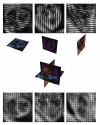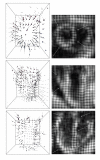3D Winding Number: Theory and Application to Medical Imaging
- PMID: 21317978
- PMCID: PMC3025358
- DOI: 10.1155/2011/516942
3D Winding Number: Theory and Application to Medical Imaging
Abstract
We develop a new formulation, mathematically elegant, to detect critical points of 3D scalar images. It is based on a topological number, which is the generalization to three dimensions of the 2D winding number. We illustrate our method by considering three different biomedical applications, namely, detection and counting of ovarian follicles and neuronal cells and estimation of cardiac motion from tagged MR images. Qualitative and quantitative evaluation emphasizes the reliability of the results.
Figures







References
-
- Wollny G, Tittgemeyer M, Kruggel F. Segmentation of vector fields by critical point analysis: application to brain deformation. In: Proceedings of International Conference on Pattern Recognition; 2002; pp. 524–527.
-
- Fu G, Hojjat SA, Colchester ACF. Detection of objects by integrating watersheds and critical point analysis. In: Proceedings of the 6th International Conference on Medical Image Computing and Computer-Assisted Intervention (MICCAI ’03); November 2003; pp. 109–116.
-
- Shinagawa Y, Kunii TL. Unconstrained automatic image matching using multiresolutional critical-point filters. IEEE Transactions on Pattern Analysis and Machine Intelligence. 1998;20(9):994–1010.
-
- Habuka K, Shinagawa Y. Image interpolation using enhanced multiresolution critical-point filters. International Journal of Computer Vision. 2004;58(1):19–35.
-
- Platel B, Balmachnova E, Florack LMJ, teer Haar Romeny BM. Top-points as interest points for image matching. In: Proceedings of the 9th European Conference on Computer Vision (ECCV ’06), vol. 3951; 2006; pp. 418–429. Lecture Notes in Computer Science.
LinkOut - more resources
Full Text Sources

